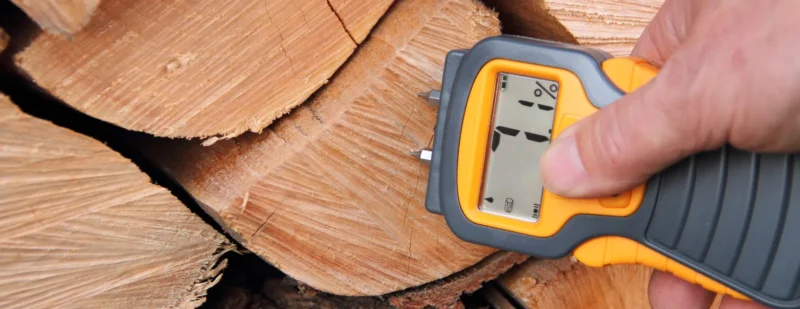Wood drying is essential for preparing lumber for woodworking projects. Woods are naturally hygroscopic, meaning they absorb moisture from the environment and release it back into the atmosphere. The natural moisture content of wood significantly impacts its strength. For example, green wood can have a moisture content ranging from 60% to 120%. Such high moisture levels weaken the wood, making it prone to cracking, warping, and shrinking. Therefore, drying wood is crucial to prevent damage and ensure durability.

This guide explores the top 4 wood drying methods—natural (air) drying, kiln drying, solar drying, dehumidifier drying, and vacuum drying. Understanding these methods, along with their advantages and disadvantages, will help you choose the best technique for your needs.
Table of Contents
Understanding Moisture Content
Wood drying is the process of removing moisture from wood. Freshly cut logs contain about 50% water by weight, meaning for every 100 pounds of wood, there are 50 pounds of water within its cells. Removing this moisture is essential to make the wood lighter and easier to transport or store compared to fresh-cut wood.
As humidity drops, the moisture content (MC) of the wood decreases, causing the wood to shrink. Conversely, as humidity increases, the MC rises, making the wood expand. Wood reaches its equilibrium moisture content (EMC) when it neither gains nor loses moisture, achieving a balance with its environment. At this point, wood no longer absorbs or releases moisture, maintaining a stable state ideal for various applications.
Top 4 Wood Drying Methods
Wood drying methods are mainly categorized into air drying and kiln drying. Air drying is a traditional, cost-effective technique that uses natural airflow to reduce moisture. Kiln drying, on the other hand, uses a controlled environment with a machine or chamber to dry the wood. Here’s a quick comparison:
| Drying Method | Moisture Content | Drying Time | Cost |
| Air Drying (Natural) | 12-20% | Several months to a year | Low |
| Kiln Drying | 6-8% | Several days to weeks | High (Initial & Operational) |
| Dehumidifier Drying | 10-12% | Several weeks | Moderate (Equipment Cost) |
| Vacuum Drying | 6-8% | Few days | Very High (Initial & Operational) |
1. Natural (Air) Drying
Air drying is the traditional method of seasoning wood, relying on natural airflow to gradually reduce the wood’s moisture content. The process involves cutting the wood into boards and stacking them with spacers in a well-ventilated, shaded area. The stack should be raised off the ground on a solid foundation to prevent moisture absorption, with stickers between layers for consistent airflow. Cover the top with a waterproof material, leaving the sides open. Regularly inspect the stack for moisture, mold, and pests. This process can take several months to over a year, so use a moisture meter to monitor progress and ensure the wood reaches the desired moisture content.

Advantages of Air Drying
- Low Cost: Air drying is inexpensive since it relies on natural elements without the need for specialized equipment.
- Eco-friendly: This method uses no energy beyond what nature provides, making it an environmentally sustainable option.
Disadvantages of Air Drying
- Time-consuming: Air drying is a slow process, often taking several months to over a year to properly dry wood.
- Weather Dependency: This method relies heavily on weather conditions, which can be unpredictable and vary greatly by location.
2. Kiln Drying
Kiln drying is a faster and more efficient method of drying wood compared to air drying.
The kiln drying process involves cutting and stacking wood with spacers, loading it into the kiln for uniform air circulation, and adjusting temperature, airflow, and humidity based on wood type and target moisture content. Start with high temperatures and low humidity, then reduce them to prevent stress. Use moisture meters to monitor moisture content. After drying, check the wood’s quality and store it in a controlled environment to prevent moisture regain.
K-Timber takes pride in our kilns, which meet European standards.

Advantages of Kiln Drying
- Speed: Kiln drying significantly reduces the drying time from months to weeks or even days.
- Consistency: Provides uniform drying, reducing the risks of warping or cracking.
- Insect Prevention: High temperatures can eliminate any wood-boring insects present in the lumber.
Disadvantages of Kiln Drying
- Higher Costs: Kiln drying involves higher initial and operational costs compared to air drying.
- Energy Consumption: The process requires substantial energy, contributing to increased operational expenses.
3. Dehumidifier
The dehumidifier drying method uses a machine to remove moisture from the air inside a sealed drying chamber. This is one of the wood drying methods that is effective in high-humidity environments, providing controlled and consistent drying conditions.
Dehumidifiers reduce the air’s humidity, circulating dry air evenly around the wood. This slower drying process preserves the wood’s quality, minimizing the risk of warping or cracking.
Using a closed room with a dehumidifier, along with a fan, can efficiently dry wood. Both residential and commercial dehumidifiers are effective, though commercial units remove more water per hour.

Advantages of Dehumidifier Drying
- Controlled Environment: Suitable for indoor use, independent of weather.
- Energy-efficient: Consumes less energy than kiln drying.
- Quality Preservation: Reduces defects by preventing rapid moisture loss.
Disadvantages of Dehumidifier Drying
- Slower Process: Takes longer to dry wood compared to kiln drying.
- Initial Setup Costs: Requires investment in dehumidifying equipment
4. Vacuum Drying
Vacuum drying involves placing wood in a sealed chamber with reduced air pressure, allowing water to evaporate at lower temperatures. This method speeds up drying while minimizing the risk of defects like warping or cracking.

Advantages of Vacuum Drying
- Faster Drying: Significantly reduces drying time.
- Quality Preservation: Minimizes defects and maintains wood integrity.
- Lower Temperatures: Preserves wood properties by drying at lower temperatures.
Disadvantages of Vacuum Drying
- Expensive Equipment: High initial investment required.
- Specialized Knowledge: Needs trained operators.
Picture of a typical machine used for vacuum drying.
Conclusion
Choosing the right one from top 4 wood drying methods—natural (air) drying, kiln drying, dehumidifier drying, or vacuum drying—is crucial for ensuring high-quality results. Each method offers unique advantages, from cost-effectiveness to speed and precision.
At K-Timber, we provide top-quality lumber expertly dried using the best techniques. Whether you prefer air-dried wood for its natural benefits or kiln-dried wood for its efficiency, we have the perfect solution for you. Our advanced dehumidifier and vacuum drying options ensure your wood is defect-free and durable.
For premium-quality, expertly dried lumber, choose K-Timber. Visit our website or contact us today to explore our range of wood products and experience the K-Timber difference!



![[K-Timber] Blog Post Boder](https://k-timbers.com/wp-content/uploads/2024/06/K-Timber-Blog-Post-Boder.jpg)






